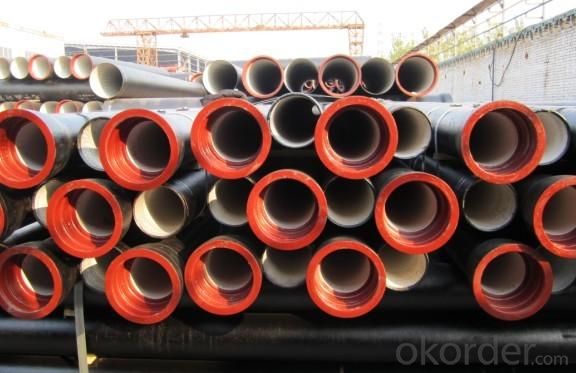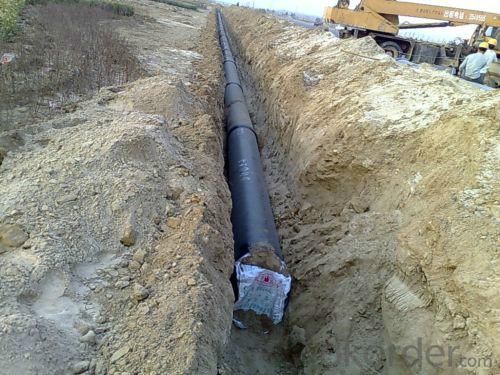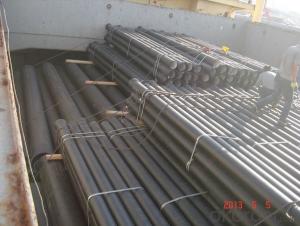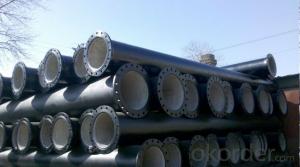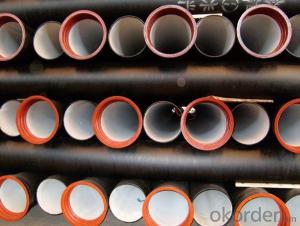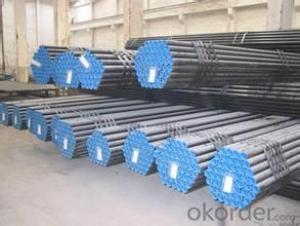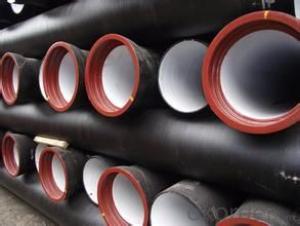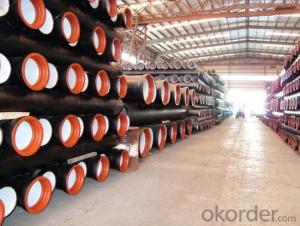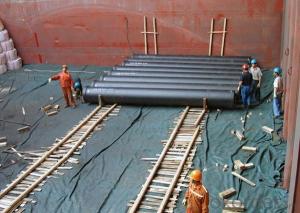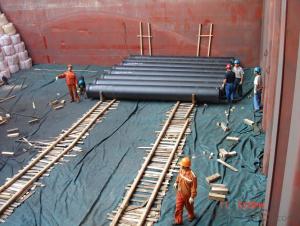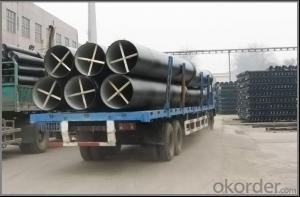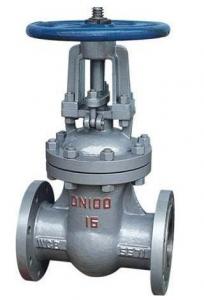Ductile Iron C-Class Flange type Length: 6M/Negotiated
- Loading Port:
- China main port
- Payment Terms:
- TT OR LC
- Min Order Qty:
- 500 m
- Supply Capability:
- 100000 m/month
OKorder Service Pledge
OKorder Financial Service
You Might Also Like
1.Ductile Iron Pipe Description :
1) Pipes confirm to ISO2531,K9 class,T type joint,6m long,with inside cements lining conform to ISO4179, outside Zinc
spraying(130g/m2) and bitumen coating(70μm) conform to ISO8179.
2) Pipe ends: Spigot and socket ends, with 100% SBR rubber gaskets accoding to ISO4633
3) we can do third party inspection according to customer's request.
4) Our products have been sold to many international market, such as Middle East and South East Asia and Africa.
2.Main Features of the Ductile Iron Pipe:
1).Quality guarantee
• Chemical checking
• NDE after rough machining
• Mechanical testing after heat treatment
• Final NDE,dimension inspected
2).Quality document
• Full Q.A document as per client request
3).Packing and Shipping
• standard export package(carton/wooden case/pallet)
• accept FOB,FAS,CNF,CIF door to door etc or customer designated shipping agent
4).Service
• Drawing: we can translate your original drawing, offer best suggestion on design
• Quality: we have full set quality control system to guarantee the best quality.
• Inspection: inspect in house, all our products must be checked 3 times before packing
3.Ductile Iron Pipe Images:
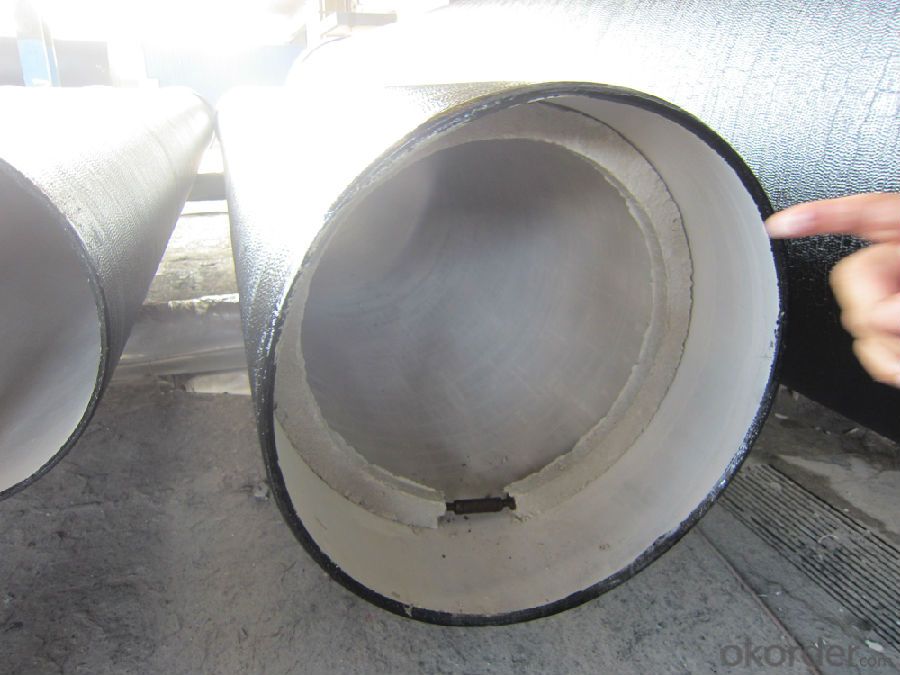

4.Ductile Iron Pipe Specification:
Surface Finishes: Bare, Oiled, Mill Varnish, Galv,FBE, FBE Dual, 3LPE, 3LPP, Coal Tar,Concrete Coating and Tape Wrap
End Finishes: Beveled, Square Cut, Threaded, hat
Additional Services: Internal Coating
Packaging: packed in bag, plastic bag, steel strip, steel wire,double wire, iron box, wooden box, tarpaulin, plastic sheeting
Inspection: MOODY SGS BV GL DNV ABS LIOYD’S
Test: X-ray, UT, magnetic particle,inspection,hydrostatic test.
Processing service: Beveling, Threading, Slotting, Cut-to length, Bends, Quench and Temper, Fabrication, Double-jointing and On-site assistance
5.FAQ:
We have organized several common questions for our clients,may help you sincerely:
1.Q: Why would you choose ductile iron pipe rather than other pipe materials?
A:The reasons are obvious for that not only ductile iron pipe possesses the inherent strength and flexibility of ductile iron, combined with proven corrosion protection systems, but also the cost savings can be achieved from design to installation and commissioning.
2.Q:Why can you guarantee the inner of pipes can’t be corroded?
A: High alumina cement mortar lining and sulphate-resistant cement mortar lining. These two special linings are applicable to inner anti-corrosion for sewage pipes, improving resistance to erosion of the sewage components.
- Q: Can ductile iron pipes be used for irrigation systems in saline soil conditions?
- Ductile iron pipes, due to their durability and corrosion resistance, can be utilized for irrigation systems in saline soil conditions. These pipes are renowned for their ability to withstand various soil conditions, including saline soil, which is characterized by elevated salt levels that can lead to corrosion and material deterioration. However, ductile iron pipes possess a protective coating, such as cement mortar lining or polyethylene encasement, that provides an added layer of defense against corrosion. Consequently, they can endure the corrosive impacts of saline soil and maintain their structural integrity for an extended duration. Moreover, ductile iron pipes exhibit a high tensile strength, enabling them to resist cracks and breaks, which is crucial for irrigation systems necessitating a consistent and dependable water supply. Consequently, ductile iron pipes represent a viable option for irrigation systems operating in saline soil conditions.
- Q: Are ductile iron pipes resistant to alkali attacks?
- Ductile iron pipes have been proven to be highly resistant to alkali attacks. The material used in ductile iron pipes, known as ductile cast iron, is formulated with specific chemical compositions that provide exceptional corrosion resistance. This resistance extends to alkali attacks, which are chemical reactions that occur when alkaline substances come into contact with metals or other materials. Ductile iron pipes have a dense and protective oxide film on their inner and outer surfaces, which acts as a barrier against chemical attacks. This oxide film forms naturally over time, and its composition and structure provide excellent resistance to alkali attacks. Additionally, ductile iron pipes are often coated with various protective layers, such as epoxy or zinc, to further enhance their resistance to corrosion and chemical reactions. It is important to note that while ductile iron pipes are highly resistant to alkali attacks, the severity and concentration of the alkali substances can still impact their overall performance. In extreme cases, very high concentrations of alkali substances or prolonged exposure to aggressive alkaline environments may eventually cause some damage to the protective layers of the pipes. However, under normal conditions and within acceptable parameters, ductile iron pipes are considered to have excellent resistance to alkali attacks.
- Q: Can ductile iron pipes be used for water supply in remote areas?
- Ductile iron pipes are indeed suitable for water supply in remote areas. Renowned for their strength, durability, and versatility, these pipes are capable of serving various purposes, including water supply systems. Notably, their exceptional resistance to corrosion and ability to endure harsh environmental conditions renders them an ideal choice for remote areas with limited maintenance and repair services. Moreover, in comparison to alternative materials, ductile iron pipes boast a significantly longer lifespan, ensuring the sustained operation of water supply systems in remote areas. In summary, the reliability of ductile iron pipes for water supply in remote areas is attributable to their resilience, resistance to corrosion, and extended lifespan.
- Q: Ductile iron pipe converter, steel transition DN100 turn 100, what is the specific accessories name? Can you supply photos?
- Strong toughness: the pipe can be stretched to 5 times the original length without fracture, which is suitable for uneven geological conditions without affecting its link performance. In the case of a breach, there is no extension of the mouth due to the breach.
- Q: Is the fire hose capable of using rapid repair joints?
- Clear。 Before installation, cleaning work should be carried out, the parts to be cleaned include: socket end, the mouth of the socket, the corner of the socket to the white line should be smooth, no sharp points, so as not to wear aprons when installation.
- Q: How is ductile iron pipe manufactured?
- The manufacturing of ductile iron pipe involves a specific process called centrifugal casting. To start, iron is melted in a furnace and certain elements like carbon and silicon are added to achieve desired properties. Once the iron is melted, it is poured into a mold or die that is rotating at a high speed. As the molten iron is poured into the rotating mold, centrifugal force causes the liquid metal to move towards the inner surface of the mold. This force results in the metal solidifying from the outer surface inward. This creates a pipe with a dense outer layer and a more porous inner layer. The centrifugal casting process guarantees that the outer surface of the pipe is free from impurities and defects, ensuring its strength and durability. Once the pipe has solidified, it is taken out of the mold and undergoes further processing. The pipe is cleaned, excess material is trimmed, and any imperfections on the surface are eliminated. It is then given a protective coating, such as zinc or epoxy, to enhance its resistance to corrosion. The final step in the manufacturing process is quality control and testing. Ductile iron pipes go through various tests to ensure they meet the required standards. These tests include hydrostatic pressure testing, dimensional inspection, and inspection of the internal and external coating. In conclusion, ductile iron pipe is manufactured using the centrifugal casting process, which involves melting iron, pouring it into a rotating mold, and allowing it to solidify under the influence of centrifugal force. The resulting pipe is then cleaned, coated, and subjected to rigorous quality control to ensure its strength, durability, and adherence to standards.
- Q: What is the difference between ductile iron pipes and cast iron pipes?
- Ductile iron pipes and cast iron pipes have different compositions, properties, manufacturing processes, and applications. Ductile iron pipes are made from a type of cast iron known as ductile iron, which contains higher levels of carbon, silicon, and other alloying elements like magnesium. On the other hand, cast iron pipes are made from regular cast iron, which has a higher carbon content and lower levels of alloying elements. In terms of properties, ductile iron pipes are recognized for their high tensile strength, flexibility, and durability. They can withstand higher pressure and have a greater resistance to impact, making them suitable for applications that demand robust performance. Conversely, cast iron pipes are more brittle and fragile, making them susceptible to cracking or breaking under pressure or impact. The manufacturing process differs as well. Ductile iron pipes are formed through centrifugal casting, in which molten ductile iron is poured into a spinning mold. This centrifugal force aids in the even distribution of the molten metal, resulting in a strong and uniform pipe. On the other hand, cast iron pipes are made using sand casting, where molten cast iron is poured into a mold made of compacted sand. This method is less precise and can result in variations in the final product. In terms of applications, ductile iron pipes are commonly used in water and sewage systems, as well as in industrial pipelines that require high-pressure resistance. Cast iron pipes, on the other hand, are typically used in non-pressure applications such as drainage systems or underground sewer lines. To summarize, ductile iron pipes and cast iron pipes differ in their composition, properties, manufacturing processes, and applications. Ductile iron pipes offer greater strength, flexibility, and durability, making them suitable for high-pressure applications, while cast iron pipes are more brittle and commonly used in non-pressure applications.
- Q: What are the different joint types available for ductile iron pipe?
- Ductile iron pipes offer a range of joint types, each with its own benefits and uses. The most commonly employed joint types in ductile iron pipe installations include: 1. Push-on Joint: This type involves inserting a rubber gasket into a groove on the pipe's spigot end. The pipe is then pushed into the bell end of the adjacent pipe, creating a watertight seal. Push-on joints are known for their quick and easy installation, making them perfect for applications that require efficiency. 2. Mechanical Joint: This joint relies on a gland and follower gasket, which are compressed between the spigot end of one pipe and the bell end of another. Bolts and nuts are used to secure the joint, ensuring a tight and secure connection. Mechanical joints provide excellent integrity and are used in applications with higher pressures or heavy loads. 3. Flanged Joint: Flanged joints utilize flanges on the pipe ends, which are bolted together with gaskets to achieve a leak-proof connection. These joints are commonly employed in situations where pipes need to be easily disconnected and reconnected, such as pump stations or valve connections. 4. Restrained Joint: These joints are specifically designed to prevent pipes from separating under high internal pressures or external forces. They typically incorporate mechanical joints with additional restraining devices like harnesses, rods, or thrust blocks. Restrained joints are commonly used in applications where pipe movement poses a risk or stability is crucial. It is important to consider factors like the application, operating conditions, and project requirements when selecting a joint type. Consulting a professional engineer or pipe manufacturer is advisable to ensure the most suitable joint type is chosen for a specific ductile iron pipe installation.
- Q: Why does the construction wastewater system use ductile iron pipes instead of galvanized steel tubes?
- The sewerage system uses ductile iron pipes. The premise should be pressure pipe drainage. It must be a special occasion, otherwise the cost will be high. In general, precast concrete pipes are recommended.
- Q: What pipe can be used to replace the cast iron pipe in the water supply? Thank you
- Cast iron pipes (Cast, Iron, Pipe), cast cast pipe. Cast iron pipes are used for water supply, drainage and gas transmission lines. They include cast iron pipes and pipe fittings. Labor intensity is small.
Send your message to us
Ductile Iron C-Class Flange type Length: 6M/Negotiated
- Loading Port:
- China main port
- Payment Terms:
- TT OR LC
- Min Order Qty:
- 500 m
- Supply Capability:
- 100000 m/month
OKorder Service Pledge
OKorder Financial Service
Similar products
Hot products
Hot Searches
Related keywords


